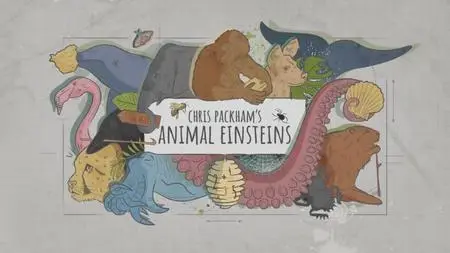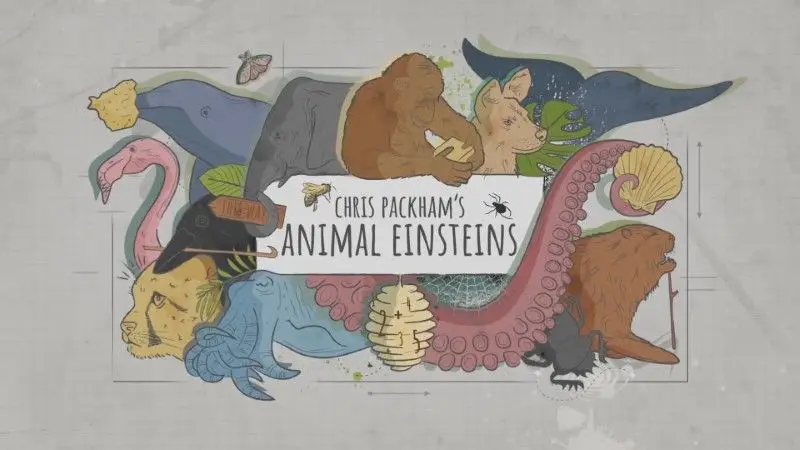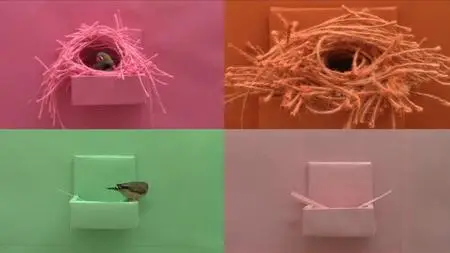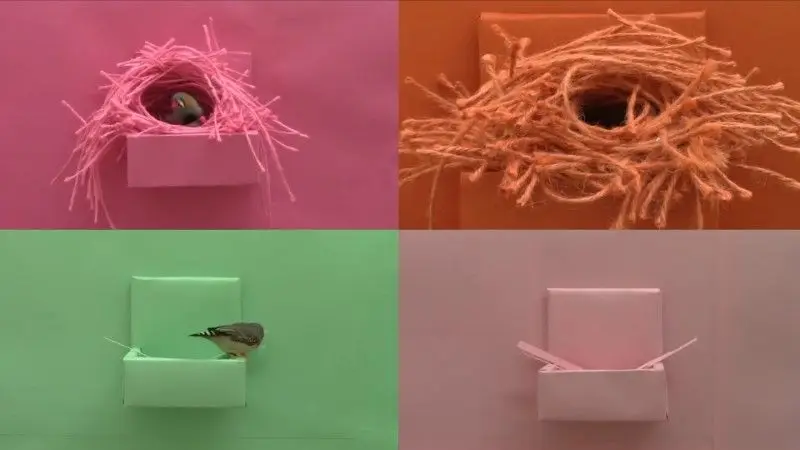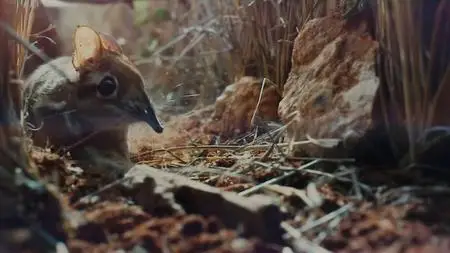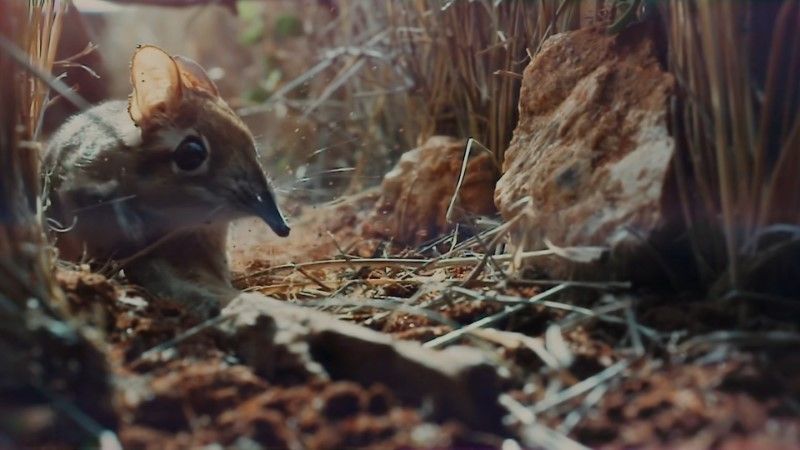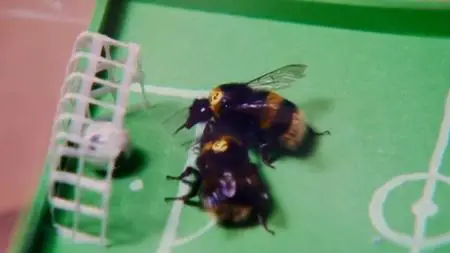BBC - Chris Packham's Animal Einsteins (2021)
HDTV | 1920 x 1080 | .MKV/HEVC @ 2471 Kbps | 6x~59mn | 6.96 GB
Audio: English AAC 132 Kbps, 2 channels | Subs: English
Genre: Documentary
HDTV | 1920 x 1080 | .MKV/HEVC @ 2471 Kbps | 6x~59mn | 6.96 GB
Audio: English AAC 132 Kbps, 2 channels | Subs: English
Genre: Documentary
Animals have to be smart to survive. Chris Packham reveals the natural world's surprising brainboxes and uncovers the clever strategies that give certain species the upper hand.
Part 1: Masterminds
Chris investigates how nature's masterminds measure up against human brain power. Looking at a variety of animals, such as ravens, crows, bees and starlings, Chris explores how different animals can use tools, solve complex puzzles, recognise themselves in mirrors and even reason like humans.
Part 2: Communicators
Chris reveals some of the cleverest animal communicators on the planet. For decades, people have longed to emulate Dr Doolittle and be able to understand what animals are communicating to one another. But their methods often go far beyond the capabilities of our human senses. Now, thanks to dedicated researchers, new science and cutting-edge technology, we're being given a glimpse into the ingenious ways that animals get their message across - that dolphins have individual names for each other, that cuttlefish use covert signals, and that humans can understand apes without even realising it.
Part 3: Builders
Finding somewhere to keep safe is one of the biggest challenges an animal faces. But some animals don't have to find a safe place - they build one. Chris reveals some of the best building animals in the world - a group that is incredibly varied. Accomplished animal architects include everything from beavers to bees and prairie dogs to bowerbirds. They don't only build homes, however - they also make structures to raise their young, store food, catch prey and impress mates. But what can be learnt from their building brilliance?
Part 4: Social Networkers
Chris looks at social intelligence in the animal kingdom and finds out why it is that, for animals, being together means being clever. He looks at how lions hunt in teams and each hold a very specific position, how vampire bats build trust and donor networks through grooming, and how wild wolves first became domesticated and transformed into man's best friend.
Part 5: Con Artists
Chris reveals the intelligent cons and deceitful behaviour that animal Einsteins use to survive and prosper in the game of life - from disguising themselves to outwit predators, and kidnapping babies to save their own offspring, to reading our body language to pull off a successful robbery.
We start with the ultimate master of disguise – the octopus. Prof Roger Hanlon describes how octopus intelligence rivals that of vertebrates, with extraordinarily fast and complex decision-making that transforms their appearance faster than the blink of an eye. If camouflage doesn't fool a predator, then an octopus can change tactics to startling them instead, switching to look like something too weird to eat.
Cheetah cubs may use a disguise of sorts too. We explore a little-known theory that a baby cheetah's appearance may fool predators into thinking they are too feisty to tackle. Young cubs bear a remarkable resemblance to honey badgers, one of the most aggressive animals in the savannah that even lions and eagles won't mess with.
Mimicry can attract as well as repel…. the caterpillars of alcon blue butterflies smell and sound like ant larvae to cleverly con their way into a nice, safe home for the winter. Worker ants are duped into taking the caterpillar into their colony, providing it with food and shelter until the spring.
The beloved sea otter may look like butter wouldn't melt in its mouth, but a hungry male has no qualms about kidnapping a pup whilst its mother is foraging. He only releases his hostage in exchange for a free meal.
In Australia, the super-social white-winged chough lives in large groups with only one pair breeding and the rest helping to raise their chicks. As Dr Constanza Leon explains, chough chicks are so needy that it takes seven birds to raise one chick and if times are hard, adults will use a special display to entice young birds from rival groups to join theirs and help out with childcare.
Dolphins are renowned for their intelligence, and we learn how calculating female bottlenose dolphins mate with multiple males to protect their future calves – if each male believes he could be the father then she reduces the chance of infanticide.
The ocean is the scene of another two-faced deceit. Competition for mates can be fierce, so some male cuttlefish use cunning tricks to get a female. For giant Australian cuttlefish size is important – so small males change their appearance and put on a female disguise to sneak past larger rivals and woo a mate. Marine biologist Dr Martin Garwood discovered that another species, the mourning cuttlefish, takes it one step further – a sneaky male splits its appearance down the middle to look male on one side (to attract a female) and female on the other to fool onlooking rival males. All's fair in love and war!
Dr Sarah Lower studies the appropriately named femme fatale firefly that has learned multiple languages to lure in unsuspecting males to an untimely death. After mating with her own species, the female firefly changes her flashes to lure in males of another species – not for mating but to eat them and so ingest valuable chemicals that protect their eggs from predators.
Finally, we discover how the much-maligned gull is actually an astute opportunist, able to read our eyeline and our body language to steal a meal when the coast is clear.
Animals use every trick in the book to get ahead – being smart, sneaky and scheming can be the recipe for success.
Part 6: Travellers
Chris discovers the clever methods that animals use to travel from A to B and how they find their way. Whether it is a local trip to find food or an epic journey to reach a safe place to breed, every traveller must work out where to go and the most energy-efficient way to get there.
Now, the latest scientific research is helping uncover just how they do it, from creating mental maps of their environment to planning their route with precision. We are only starting to understand how these intelligent travellers get around successfully, but by studying their movements we may also learn valuable insights that could help us, like ways to manage crowd safety and to how to tackle cancer more effectively.
Chris begins by meeting Bertie and Baxter, two beautiful Bactrian camels that demonstrate how they are perfectly adapted to trekking across harsh deserts. With long eyelashes and special eyelids to keep out sand, broad feet so they do not sink, and the ability to go without water for up to a week, these camels can cover 25 miles a day, and helped humans travel and trade for thousands of years.
In America, Rhiannon Jakopak from the University of Wyoming is part of a research team collaring and tracking mule deer across the state. They are finding that mule deer are constantly collecting details about the environment and their position within it, allowing them to learn migration routes passed down the generations, and even occasionally learning their own new routes.
Some ocean migrants are also showing impressive brainpower, as Dr Briana Abhrams from the University of Washington has discovered. Her research has shown blue whales use their memories to migrate, letting them predict where and when there will be a steady supply of food all along the west coast of North America, as they undertake their epic 4,000-mile-long migration.
Elephants have a reputation for never forgetting, and it seems their memory can help them find valuable resources. Sophie Sadera is a safari guide in the Maasai Mara National Reserve and she knows first-hand how elephants use the same pathways every year as they travel to find water. During times of drought matriarchs can use their memory of water sources they have visited in the past to ensure their herd's survival.
But you do not need to have a big brain to find your way around. The green and black poison dart frog lives in the rainforests of South America and is a master of mental maps. Brand new science has shown this tiny amphibian has got the mind to remember the structure of a rainforest, which is constantly changing, enabling them to transport their tadpoles to water sources within this dynamic environment.
Exciting new research by Rickesh Patel, from the University of Maryland Baltimore County, has revealed an excellent underwater navigator. By constantly monitoring the turns they take and the distance they travel, mantis shrimp can find their way back to their home. This suggests they use a navigational strategy called path integration. They are currently the only underwater animal that we know of that is able to do this.
Professor Marie Dacke, from Lund University in Sweden, has been studying dung beetles in South Africa for over 20 years, and her research has discovered that these insects have the remarkable ability to navigate at night using the light of the Milky Way.
Some animal travellers use the most surprising ways to get around, and new science by the University of Bristol has shown how spiders can fly. By detecting static electricity in the air, they float along on silk lines. They have been found an impressive 1,000 miles out at sea, and up to two-and-a-half miles high in the air.
But they are not the only surprising flyer, the Paradise Tree Snake can cover almost 100 metres in a single glide. Now, thanks to motion-capture technology, new research has revealed the science behind how they can glide and land safely.
Some of the most exciting discoveries are coming from studying how animals travel en masse. Dr Iain Couzin, from the Max Planck Institute in Germany, is showing that bird flocks and fish shoals tap into a 'group mind' influencing how they travel. Their behaviour may hold answers to some human problems, like how to manage crowd safety and even new ways to treat cancer.
Chris takes us on a trip into the remarkable world of animal travel. By getting up close and personal with some of the nature's best travellers, Chris reveals the remarkable intelligence these Animal Einsteins use to journey around our planet.
General
Unique ID : 333524975687505947971676874106769754305 (0xFAEA92E3C12CD5261DBC4F7356D7C8C1)
Complete name : BBC.Chris.Packhams.Animal.Einsteins.1of6..mkv
Format : Matroska
Format version : Version 4
File size : 1.07 GiB
Duration : 59 min 0 s
Overall bit rate : 2 605 kb/s
Movie name : Chris Packham's Animal Einsteins []
Encoded date : UTC 2021-03-31 12:15:18
Writing application : mkvmerge v55.0.0 ('Waiting For Space') 64-bit
Writing library : libebml v1.4.2 + libmatroska v1.6.4
Video
ID : 1
Format : HEVC
Format/Info : High Efficiency Video Coding
Format profile : Main@L4@Main
Codec ID : V_MPEGH/ISO/HEVC
Duration : 59 min 0 s
Bit rate : 2 471 kb/s
Width : 1 920 pixels
Height : 1 080 pixels
Display aspect ratio : 16:9
Frame rate mode : Constant
Frame rate : 25.000 FPS
Color space : YUV
Chroma subsampling : 4:2:0
Bit depth : 8 bits
Bits/(Pixel*Frame) : 0.048
Stream size : 1.02 GiB (95%)
Writing library : x265 3.4+36-5239276dd:[Windows][MSVC 1928][64 bit] 8bit
Encoding settings : cpuid=1111039 / frame-threads=3 / numa-pools=12 / wpp / no-pmode / no-pme / no-psnr / no-ssim / log-level=2 / input-csp=1 / input-res=1920x1080 / interlace=0 / total-frames=50 / level-idc=0 / high-tier=1 / uhd-bd=0 / ref=3 / no-allow-non-conformance / no-repeat-headers / annexb / no-aud / no-hrd / info / hash=0 / no-temporal-layers / no-open-gop / min-keyint=25 / keyint=250 / gop-lookahead=12 / bframes=6 / b-adapt=2 / b-pyramid / bframe-bias=0 / rc-lookahead=20 / lookahead-slices=6 / scenecut=40 / hist-scenecut=0 / radl=0 / no-splice / no-intra-refresh / ctu=64 / min-cu-size=8 / no-rect / no-amp / max-tu-size=32 / tu-inter-depth=1 / tu-intra-depth=1 / limit-tu=0 / rdoq-level=0 / dynamic-rd=0.00 / no-ssim-rd / signhide / no-tskip / nr-intra=0 / nr-inter=0 / no-constrained-intra / strong-intra-smoothing / max-merge=3 / limit-refs=1 / no-limit-modes / me=2 / subme=2 / merange=48 / temporal-mvp / no-frame-dup / hme / Level / merange / L0,L1,L2=16,32,48 / weightp / weightb / no-analyze-src-pics / deblock=0:0 / sao / no-sao-non-deblock / rd=3 / selective-sao=4 / early-skip / rskip / no-fast-intra / no-tskip-fast / no-cu-lossless / b-intra / no-splitrd-skip / rdpenalty=0 / psy-rd=2.00 / psy-rdoq=0.00 / no-rd-refine / no-lossless / cbqpoffs=0 / crqpoffs=0 / rc=crf / crf=22.0 / qcomp=0.60 / qpstep=4 / stats-write=0 / stats-read=0 / ipratio=1.40 / pbratio=1.30 / aq-mode=4 / aq-strength=1.00 / cutree / zone-count=0 / no-strict-cbr / qg-size=32 / no-rc-grain / qpmax=69 / qpmin=0 / no-const-vbv / sar=1 / overscan=0 / videoformat=5 / range=0 / colorprim=1 / transfer=1 / colormatrix=1 / chromaloc=0 / display-window=0 / cll=0,0 / min-luma=0 / max-luma=255 / log2-max-poc-lsb=8 / vui-timing-info / vui-hrd-info / slices=1 / no-opt-qp-pps / no-opt-ref-list-length-pps / no-multi-pass-opt-rps / scenecut-bias=0.05 / hist-threshold=0.03 / no-opt-cu-delta-qp / no-aq-motion / no-hdr10 / no-hdr10-opt / no-dhdr10-opt / no-idr-recovery-sei / analysis-reuse-level=0 / analysis-save-reuse-level=0 / analysis-load-reuse-level=0 / scale-factor=0 / refine-intra=0 / refine-inter=0 / refine-mv=1 / refine-ctu-distortion=0 / no-limit-sao / ctu-info=0 / no-lowpass-dct / refine-analysis-type=0 / copy-pic=1 / max-ausize-factor=1.0 / no-dynamic-refine / no-single-sei / no-hevc-aq / no-svt / no-field / qp-adaptation-range=1.00 / scenecut-aware-qp=0conformance-window-offsets / right=0 / bottom=0 / decoder-max-rate=0 / no-vbv-live-multi-pass
Language : English
Default : Yes
Forced : No
Color range : Limited
Color primaries : BT.709
Transfer characteristics : BT.709
Matrix coefficients : BT.709
Audio
ID : 2
Format : AAC LC
Format/Info : Advanced Audio Codec Low Complexity
Codec ID : A_AAC-2
Duration : 58 min 59 s
Bit rate : 132 kb/s
Channel(s) : 2 channels
Channel layout : L R
Sampling rate : 48.0 kHz
Frame rate : 46.875 FPS (1024 SPF)
Compression mode : Lossy
Stream size : 55.6 MiB (5%)
Language : English
Default : Yes
Forced : No
Text
ID : 3
Format : UTF-8
Codec ID : S_TEXT/UTF8
Codec ID/Info : UTF-8 Plain Text
Duration : 58 min 27 s
Bit rate : 90 b/s
Count of elements : 949
Stream size : 38.9 KiB (0%)
Language : English
Default : No
Forced : No
Unique ID : 333524975687505947971676874106769754305 (0xFAEA92E3C12CD5261DBC4F7356D7C8C1)
Complete name : BBC.Chris.Packhams.Animal.Einsteins.1of6..mkv
Format : Matroska
Format version : Version 4
File size : 1.07 GiB
Duration : 59 min 0 s
Overall bit rate : 2 605 kb/s
Movie name : Chris Packham's Animal Einsteins []
Encoded date : UTC 2021-03-31 12:15:18
Writing application : mkvmerge v55.0.0 ('Waiting For Space') 64-bit
Writing library : libebml v1.4.2 + libmatroska v1.6.4
Video
ID : 1
Format : HEVC
Format/Info : High Efficiency Video Coding
Format profile : Main@L4@Main
Codec ID : V_MPEGH/ISO/HEVC
Duration : 59 min 0 s
Bit rate : 2 471 kb/s
Width : 1 920 pixels
Height : 1 080 pixels
Display aspect ratio : 16:9
Frame rate mode : Constant
Frame rate : 25.000 FPS
Color space : YUV
Chroma subsampling : 4:2:0
Bit depth : 8 bits
Bits/(Pixel*Frame) : 0.048
Stream size : 1.02 GiB (95%)
Writing library : x265 3.4+36-5239276dd:[Windows][MSVC 1928][64 bit] 8bit
Encoding settings : cpuid=1111039 / frame-threads=3 / numa-pools=12 / wpp / no-pmode / no-pme / no-psnr / no-ssim / log-level=2 / input-csp=1 / input-res=1920x1080 / interlace=0 / total-frames=50 / level-idc=0 / high-tier=1 / uhd-bd=0 / ref=3 / no-allow-non-conformance / no-repeat-headers / annexb / no-aud / no-hrd / info / hash=0 / no-temporal-layers / no-open-gop / min-keyint=25 / keyint=250 / gop-lookahead=12 / bframes=6 / b-adapt=2 / b-pyramid / bframe-bias=0 / rc-lookahead=20 / lookahead-slices=6 / scenecut=40 / hist-scenecut=0 / radl=0 / no-splice / no-intra-refresh / ctu=64 / min-cu-size=8 / no-rect / no-amp / max-tu-size=32 / tu-inter-depth=1 / tu-intra-depth=1 / limit-tu=0 / rdoq-level=0 / dynamic-rd=0.00 / no-ssim-rd / signhide / no-tskip / nr-intra=0 / nr-inter=0 / no-constrained-intra / strong-intra-smoothing / max-merge=3 / limit-refs=1 / no-limit-modes / me=2 / subme=2 / merange=48 / temporal-mvp / no-frame-dup / hme / Level / merange / L0,L1,L2=16,32,48 / weightp / weightb / no-analyze-src-pics / deblock=0:0 / sao / no-sao-non-deblock / rd=3 / selective-sao=4 / early-skip / rskip / no-fast-intra / no-tskip-fast / no-cu-lossless / b-intra / no-splitrd-skip / rdpenalty=0 / psy-rd=2.00 / psy-rdoq=0.00 / no-rd-refine / no-lossless / cbqpoffs=0 / crqpoffs=0 / rc=crf / crf=22.0 / qcomp=0.60 / qpstep=4 / stats-write=0 / stats-read=0 / ipratio=1.40 / pbratio=1.30 / aq-mode=4 / aq-strength=1.00 / cutree / zone-count=0 / no-strict-cbr / qg-size=32 / no-rc-grain / qpmax=69 / qpmin=0 / no-const-vbv / sar=1 / overscan=0 / videoformat=5 / range=0 / colorprim=1 / transfer=1 / colormatrix=1 / chromaloc=0 / display-window=0 / cll=0,0 / min-luma=0 / max-luma=255 / log2-max-poc-lsb=8 / vui-timing-info / vui-hrd-info / slices=1 / no-opt-qp-pps / no-opt-ref-list-length-pps / no-multi-pass-opt-rps / scenecut-bias=0.05 / hist-threshold=0.03 / no-opt-cu-delta-qp / no-aq-motion / no-hdr10 / no-hdr10-opt / no-dhdr10-opt / no-idr-recovery-sei / analysis-reuse-level=0 / analysis-save-reuse-level=0 / analysis-load-reuse-level=0 / scale-factor=0 / refine-intra=0 / refine-inter=0 / refine-mv=1 / refine-ctu-distortion=0 / no-limit-sao / ctu-info=0 / no-lowpass-dct / refine-analysis-type=0 / copy-pic=1 / max-ausize-factor=1.0 / no-dynamic-refine / no-single-sei / no-hevc-aq / no-svt / no-field / qp-adaptation-range=1.00 / scenecut-aware-qp=0conformance-window-offsets / right=0 / bottom=0 / decoder-max-rate=0 / no-vbv-live-multi-pass
Language : English
Default : Yes
Forced : No
Color range : Limited
Color primaries : BT.709
Transfer characteristics : BT.709
Matrix coefficients : BT.709
Audio
ID : 2
Format : AAC LC
Format/Info : Advanced Audio Codec Low Complexity
Codec ID : A_AAC-2
Duration : 58 min 59 s
Bit rate : 132 kb/s
Channel(s) : 2 channels
Channel layout : L R
Sampling rate : 48.0 kHz
Frame rate : 46.875 FPS (1024 SPF)
Compression mode : Lossy
Stream size : 55.6 MiB (5%)
Language : English
Default : Yes
Forced : No
Text
ID : 3
Format : UTF-8
Codec ID : S_TEXT/UTF8
Codec ID/Info : UTF-8 Plain Text
Duration : 58 min 27 s
Bit rate : 90 b/s
Count of elements : 949
Stream size : 38.9 KiB (0%)
Language : English
Default : No
Forced : No
Screenshots
Welcome to my blog - daily update!


